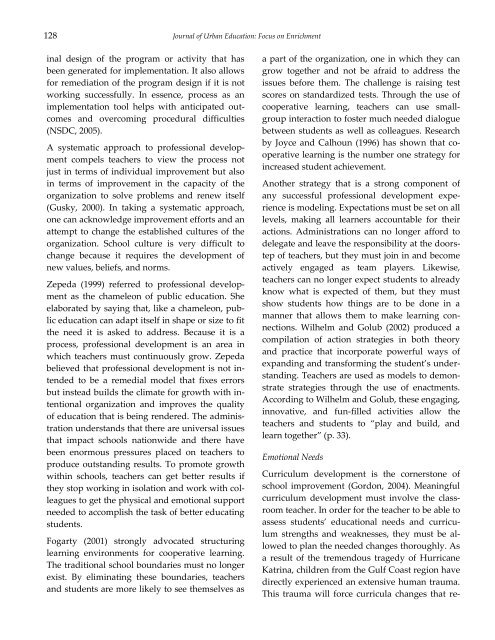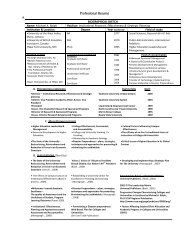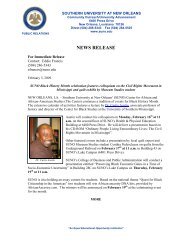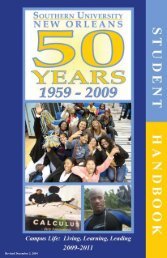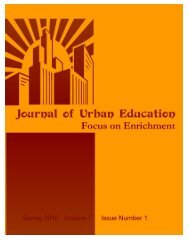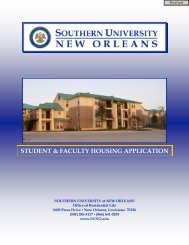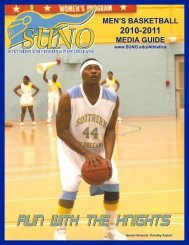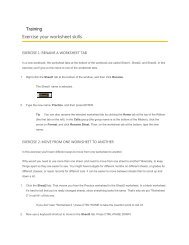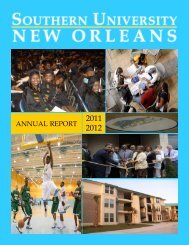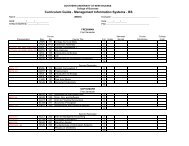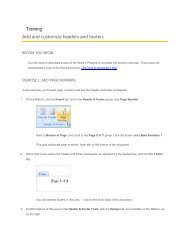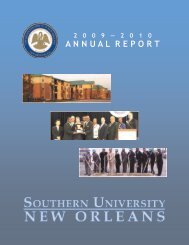Journal of - Southern University New Orleans
Journal of - Southern University New Orleans
Journal of - Southern University New Orleans
- No tags were found...
Create successful ePaper yourself
Turn your PDF publications into a flip-book with our unique Google optimized e-Paper software.
128 <strong>Journal</strong> <strong>of</strong> Urban Education: Focus on Enrichmentinal design <strong>of</strong> the program or activity that hasbeen generated for implementation. It also allowsfor remediation <strong>of</strong> the program design if it is notworking successfully. In essence, process as animplementation tool helps with anticipated outcomesand overcoming procedural difficulties(NSDC, 2005).A systematic approach to pr<strong>of</strong>essional developmentcompels teachers to view the process notjust in terms <strong>of</strong> individual improvement but alsoin terms <strong>of</strong> improvement in the capacity <strong>of</strong> theorganization to solve problems and renew itself(Gusky, 2000). In taking a systematic approach,one can acknowledge improvement efforts and anattempt to change the established cultures <strong>of</strong> theorganization. School culture is very difficult tochange because it requires the development <strong>of</strong>new values, beliefs, and norms.Zepeda (1999) referred to pr<strong>of</strong>essional developmentas the chameleon <strong>of</strong> public education. Sheelaborated by saying that, like a chameleon, publiceducation can adapt itself in shape or size to fitthe need it is asked to address. Because it is aprocess, pr<strong>of</strong>essional development is an area inwhich teachers must continuously grow. Zepedabelieved that pr<strong>of</strong>essional development is not intendedto be a remedial model that fixes errorsbut instead builds the climate for growth with intentionalorganization and improves the quality<strong>of</strong> education that is being rendered. The administrationunderstands that there are universal issuesthat impact schools nationwide and there havebeen enormous pressures placed on teachers toproduce outstanding results. To promote growthwithin schools, teachers can get better results ifthey stop working in isolation and work with colleaguesto get the physical and emotional supportneeded to accomplish the task <strong>of</strong> better educatingstudents.Fogarty (2001) strongly advocated structuringlearning environments for cooperative learning.The traditional school boundaries must no longerexist. By eliminating these boundaries, teachersand students are more likely to see themselves asa part <strong>of</strong> the organization, one in which they cangrow together and not be afraid to address theissues before them. The challenge is raising testscores on standardized tests. Through the use <strong>of</strong>cooperative learning, teachers can use smallgroupinteraction to foster much needed dialoguebetween students as well as colleagues. Researchby Joyce and Calhoun (1996) has shown that cooperativelearning is the number one strategy forincreased student achievement.Another strategy that is a strong component <strong>of</strong>any successful pr<strong>of</strong>essional development experienceis modeling. Expectations must be set on alllevels, making all learners accountable for theiractions. Administrations can no longer afford todelegate and leave the responsibility at the doorstep<strong>of</strong> teachers, but they must join in and becomeactively engaged as team players. Likewise,teachers can no longer expect students to alreadyknow what is expected <strong>of</strong> them, but they mustshow students how things are to be done in amanner that allows them to make learning connections.Wilhelm and Golub (2002) produced acompilation <strong>of</strong> action strategies in both theoryand practice that incorporate powerful ways <strong>of</strong>expanding and transforming the student’s understanding.Teachers are used as models to demonstratestrategies through the use <strong>of</strong> enactments.According to Wilhelm and Golub, these engaging,innovative, and fun-filled activities allow theteachers and students to ‚play and build, andlearn together‛ (p. 33).Emotional NeedsCurriculum development is the cornerstone <strong>of</strong>school improvement (Gordon, 2004). Meaningfulcurriculum development must involve the classroomteacher. In order for the teacher to be able toassess students’ educational needs and curriculumstrengths and weaknesses, they must be allowedto plan the needed changes thoroughly. Asa result <strong>of</strong> the tremendous tragedy <strong>of</strong> HurricaneKatrina, children from the Gulf Coast region havedirectly experienced an extensive human trauma.This trauma will force curricula changes that re-


